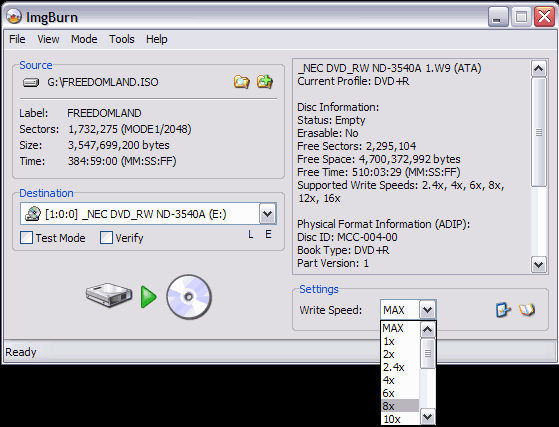Download Iso Img Files Bochs For Android
- And finally, start using Windows XP on our android device. Let’s begin now, First of all, download all the files below. Windows 98/Windows XP ISO file. Qemu Manager for PC. Bochs emulator For Android. Blank Disk Image. After downloading above files finally, we are ready to install windows on android.
- Bochs free download - lBochs PC Emulator, Villeroy & Boch, il Boch, and many more programs.
- Bochs Disk Images. These disk images are for use with the Bochs x86 Emulator.I am providing them to make it easier to get started with hacking Bochs. All of them were built and tested using Bochs 2.6.2 compiled with the following configure options.
- Prepare the image of Windows XP (ISO files). Put Bochs on Android. Prepare a Windows XP installation CD image file form. Iso then setting the Virtual Hard Disk Virtual Box or Qemu on your PC. With the following provisions: a. Open Qemu or Virtual Box b. Select 'New Virtual Machine' c. Create a blank virtual hard drive named.
The plan9 image is an ISO format file that can be interpreted using the ISO 9660 format (as an emulation of a CD-ROM drive, which you'll see shortly). The next step is to create your VHD. Recall that this will be a file on the host operating system. Bochs provides a special utility to create this file called bximage.
This was contributed by Greg Alexander in October 2001 and updated byVolker Ruppert in October 2013.
What you need:
An executable version of Bochs. See Downloading Bochs and Compiling Bochs.
The bximage program, included with Bochs.
A FreeDOS boot disk, or a boot disk from another OS capable ofproducing DOS partitions (e.g. a Linux install disk).
(Optional) mtools, a program for manipulating DOS disks/images.
 8.2.1. Create a flat image
8.2.1. Create a flat imageOption 1: Using the Unix
You will need to know the geometry of the disk you want tocreate. You have to compute the disk sector count:
Use the dd command to create your file:(replace 'sectors' with the number you computed at theprevious step).
When you'll update your configuration file, pleasefill in the same cylinders, heads and sector pertrack values.
Option 2: Run
Since we want to create a new image, we have to type '1'and then
Since we are creating a hard disk image, accept the default of hd bypressing
We want to create a simple flat image, so accept the defaultby pressing
Enter the size of the hard disk you want to create, and press
At this point, type in the filename you want to use for the image. Thedefault of 'c.img' is appropriate if this will be your only hard diskimage. After you have typed in the name of the filename you want touse, press
The following line should appear in your
At this point, a file called 'teaching.img' was created in my currentdirectory and is ready to be used as an image file for a Bochs session.
Tip: You may want to name your image
Option 1: Using FreeDOS (Advantage: Creates a MBR on the partition.)
First, you need to edit the
Also, you need to download or create a FreeDOS (or DOS, or Windows, orLinux) disk image. Modify the 'floppya:' line in your
Save and close your
Use the standard FreeDOS commands
Option 2: Using mtools (Disadvantage: Cannot create bootable imageswithout a MBR image.)
Use a text editor to add the following line to the file
Save and close
For example, for my 10 meg drive, I used:
Next, format the partition you just created using the mformat command:
And you now have a formatted disk image containing a single DOSpartition.
Note: The mpartition command doesn't handle images larger than 1024 cylinders properly.The partition size reported by fdisk is okay, but mformat reports only 504 MB(tested with mtools 3.9.9).
Linux ISO images are a very efficient way to download and install a distribution. All that is required is sufficient drive space, software to write the ISO image and a bootable media such as CD/DVD or USB flash drive.
Below you will find links to Linux ISO Image Downloads for mainstream Linux distributions.
What is an ISO image?
In the context of files and programs, an 'image', whether an ISO or other media image, is simply a file that can be used as an identical copy of the original media. This file not only contains individual data files, but it also contains track and sector information and arranges all this information in a file system, just like disk media. Image files, unlike normal files, are usually not opened; rather, they are mounted.
An ISO image (.iso) is simply a CD-ROM image saved in ISO-9660 format. ISO images are mainly used as source files from which to create CDs. As an example, most distributions of Linux release ISO images of the installation CDs. These images are usually freely available online. Once you download the image, you can use software to recreate the physical installation media.
Learn HowTo create an ISO image file with Linux.
About these Linux Distributions
More information on each of these Linux Distributions is available if you're interested in learning about their features and different editions such as Desktop, Server / Enterprise, LiveCD or NetBook / IoT.
Download Iso Img Files Bochs For Android Phone
DebianOfficial download: Debian ISO Official mirrors: N/A |
UbuntuOfficial download: Ubuntu ISO Official mirrors: N/A |
Linux MintOfficial download: Linux Mint ISO Official mirrors: N/A |
Arch LinuxOfficial download: Arch Linux ISO Official mirrors: Arch Linux Mirror |
FedoraOfficial download: Fedora Workstation ISO Official download: Fedora Server ISO Official mirrors: Fedora ISO Mirror |
CentOSOfficial download: CentOS ISO Official mirrors: CentOS Mirror |
openSUSEOfficial download: openSUSE ISO Official mirrors: N/A |
Red Hat Enterprise Linux (RHEL)Official download: Red Hat Enterprise Linux ISO Official mirrors: N/A |
GentooOfficial download: Gentoo ISO Official mirrors: N/A |
Extract Img Files Free
RaspbianOfficial download: Raspbian ISO Official mirrors: N/A |